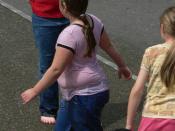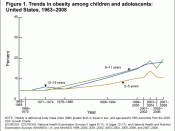According to recent federal findings, the number of American children from the ages of six to eleven has tripled in the last forty-years, with one in every seven of these children meeting the criteria for obesity (Better Nutrition 28). Children, like the rest of Americans, are living more and more sedentary life styles. Childhood obesity in school-aged children is rising, and it's the responsibility of the parents to prevent this from happening to their own children.
Much more than an aesthetic issue, childhood obesity is a major health problem. Today, one in five school-age children fulfill the medical definition of obese, weighing 25% more than the ideal for his or her height and age (Spake 40). In the last decade, the incidence of obesity among children ages 6-11 has doubled, and in adolescents it has tripled (Spake 40). A growing wave of obesity among children is helping to fuel a parallel epidemic in the rate of diabetes, especially Type II diabetes, the so-called non-insulin-dependent diabetes (Childhood Obesity). This is a dangerous disease that once struck mostly at middle age. How much of this will a parent ignore before the consequences become real? Diabetes is not the only issue; overweight children may also have greater difficulty with high blood pressure, high cholesterol levels, orthopedic problems, heart disease, stroke, sleeping habits, as well as having low self-esteem, and problems with peer relationships (Childhood Obesity). All of these are symptoms that can carry over into their adult lives if left untreated. There is no single cause of obesity, but parents need to be aware of signs this growing problem in their own family.
There are several theories to try to explain or to just shift the blame for the problem. Some children don't get the exercise they need daily,



Work in progress
Although I believe that overall this is a good essay, I think it could be better with some minor adjustments. For example the author uses a lot of information and statistics from other articles, and although the source is put in (parentheses) aside it, s/he doesn't have a formal bibliography. Because of this the reader doesn't know what year the articles or sources were written in, or the creditability of the authors who wrote them. Overall when reading one can tell that it is a high school level paper. However I must give credit that the author has a definite distinct voice and tone throughout the essay.
1 out of 1 people found this comment useful.